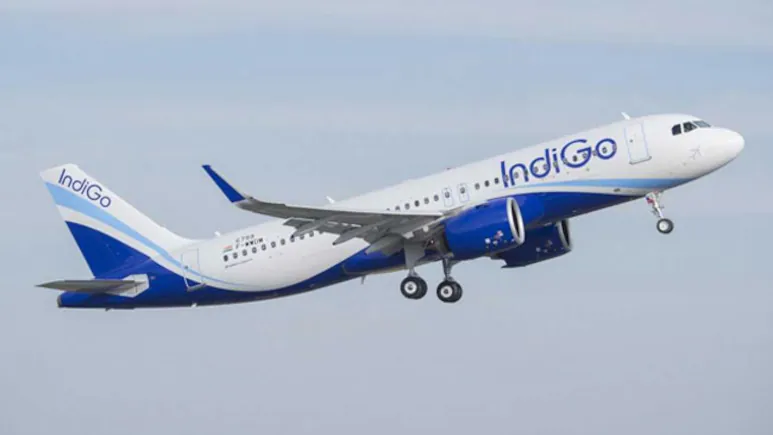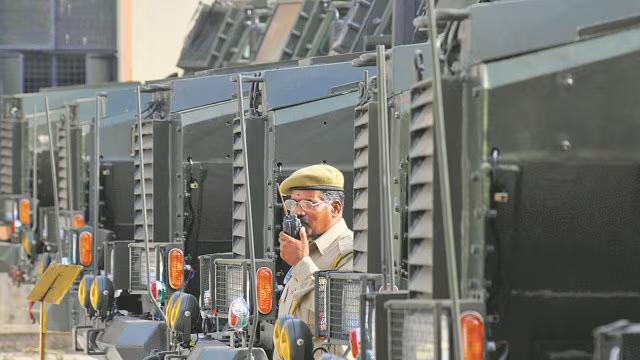A recent near-miss in Indian skies has put the spotlight back on air safety. IndiGo flight 6E-6764 declared a mayday due to low fuel and landed safely in Bengaluru. While no one was harmed, the incident has ignited serious discussions about aviation safety, fuel protocols, pilot stress, and infrastructure readiness. Here’s a full breakdown of what happened and why it matters.
IndiGo’s Mayday Scare: A Near-Miss Prompting Tough Questions On Fuel, Safety, and Systemic Stress
There was a near tragedy in the Indian skies this week that has the aviation circles in the country buzzing with concern about air safety. Mayday landing at Bengaluru – a IndiGo flight 6E 6764 from Guwahati to Chennai with 168 passengers on board made a mayday landing at the Bengaluru airport on Wednesday following an emergency as the aircraft was low on fuel. Though the incident was ultimately resolved without any injuries or damages, it underscores the increasing strain placed on aviation infrastructure and the capacity for high-stakes decision-making under pressure.
Although the passengers touched down safely, the incident raised serious questions about flight plans, fuel reserves, airport overcrowding, and safety alarms. This also comes only days after a terrifying Air India Dreamliner crash in Ahmedabad and the skies over India feel much less reliable than is usual.
Here’s a look at what happened, how it went down and what it means for India’s aviation industry.
Also read, 5 Air India Dreamliner International Flights Cancelled Today
A Routine Trip That Became an Emergency
Flight details: On June 19th, 2020, IndiGo flight 6E-6764, an Airbus A321, took off from Guwahati at 4:40 pm for Chennai. The flight was to land in Chennai around 7.45 pm. But the routine trip rapidly descended into the realm of nightmare.
The met conditions at the Chennai airport started to worsen by the time the flight was supposed to land. The pilots were unable to land due to the poor weather and traffic and they had to make a fly past. The situation ordered the aircraft to hold, which wastes precious fuel.
The pilots decided to change course and head to Bengaluru. But by that point, the plane was running dangerously low on fuel. Sensing the urgency, the pilot declared a “mayday” – an international distress signal employed when in a life-threatening situation – because of what the airline described as “insufficient fuel.”
Timeline of the Incident
- 4:40 PM – Flight 6E-6764 departs from Guwahati.
- 7:45 PM – Invited landing time at Chennai.
- 7:45 – 8:00 PM – Pilot flying over Chennai, unable to land because of weather and congestion.
- 8:00 PM (approx) – Flight diverted to Bengaluru.
- 8:20 PM – Aircraft makes safe landing in Bengaluru after issuing a mayday call.
The airline said the decision to declare a mayday was done out of an abundance of caution and safety procedures. “The pilot decided to divert the flight to Bangalore, but realised that they had run out of fuel. So he pressed PAN and informed the airport with a mayday call,” an IndiGo spokesperson said.
Both pilots were immediately derostered – an industry practice that means they have been relieved from duty pending an internal investigation.
Also read, Ahmedabad Plane Crash : What Global Aviation Safety Rules Says
The Bigger Question: How Did We Get Here?
Although the successful safe landing brought relief, the fact that a commercial plane with 168 passengers on board had to declare a mayday because it ran out of fuel sent shivers down the spine of the aviation industry.
Several aviation experts and analysts note that although congestion and lousy weather are everyday occurrences, the amount of extra fuel carried in such situations is supposed to prevent matters from getting so out of hand that a mayday would have to be declared. Aviation is very strictly regulated with fuel requirements.
So what failed?
- Weather Disruption – Bad weather in Chennai then did not allow a landing clearance.
- Airport Congestion – The delay was also affected by availability of the airport facility for the aircraft.
- Fuel Planning? – Did the flight have enough fuel for potential diversions and for delays? That remains under scrutiny.
In a high-stakes setting, the mix of nature, logistics and commercial aviation pressure can align into inflection points. It’s what pilots are trained to handle – but it’s also a test of the systems that are supposed to support them.
A Pattern Emerges: Not Just One-Off Cases
This IndiGo incident is not an exception. Just a day later, on Friday, a second Indigo aircraft, this one heading for Madurai, developed a technical problem in the air and was forced to turn back to Chennai. The flight, with 68 passengers on board, landed safely and all passengers were deboarded with proper safety protocol.
And a week before that, on June 12, something immeasurably sadder happened. An Air India Boeing 787-8 Dreamliner sent out a mayday call before diving into Ahmedabad, colliding with apartment buildings and exploding into a fireball. While the cause of that crash is still under investigation, the mayday call in both instances highlights increased stress in India’s air corridors.
Together, these episodes hint at a systemic challenge – a system stretched thin by growing air traffic, erratic weather and, some say, operational short cuts.
Also read, Ahmedabad Air India Plane Crash On June 12 2025
Why Fuel Emergencies Are Such Big Deals
It is not standard practice to declare a mayday for low fuel. It is the most serious call a pilot can make, and means the aircraft will be unable to remain in the sky and must be prioritized for landing at the nearest airport.
In aviation, there are fuel alert levels:
- Minimum Fuel – A caution message to indicate that the aircraft does not have much more fuel, but is still able to safely continue.
- Fuel Emergency (Mayday) – Airplane no longer has enough fuel to reach destination or alternate, and needs to land immediately.
Fuel-related mayday calls are rare and usually result after multiple missed opportunities or failure to adhere to standard procedures. So the Guwahati-Chennai flight episode is particularly disturbing.
Accountability and Response
In the wake of the incident, IndiGo has issued a statement stating its decision to take both pilots off the roster while conducting an inquiry on the case. India’s civil aviation regulator, the Directorate General of Civil Aviation (DGCA), is expected to carry out a detailed probe of the incident, focusing on fuel planning, decision-making processes and air traffic control coordination.
While IndiGo has said its crew followed rules to ensure a safe landing, passenger safety advocates and unions are pressing for transparency.
Questions being asked include:
- Did the flight have fuel on board according to DGCA norms?
- Were pilots ever encouraged not to divert over costs?
- Did Chennai’s ground handling and air traffic control staff have adequate manpower and were they responsive enough?
The Human Element: Stress in the Skies
Apart from the numbers and technicalities, one has to remember that the skies aren’t flown by machines alone. Life in the cockpit can be extremely stressful, particularly when pilots are confronted with emergencies. It is the decision to divert, the judgment to declare a mayday and the ability to land safely under pressure that brings home the realization of their skill and responsibility.
At the same time, all of this is wearing on. Derostering is necessary, not just to ascertain what went wrong but to allow the pilots’ vital mental and emotional break. The human element is lost amid the relentless schedules of modern aviation.
What Lies Ahead: Systemic Reform or a Band-Aid?
Indeed, the recent spate of accidents is indicative of the fact that Indian aviation requires a period of introspection. As the number of passengers grows and the routes expand, the system should develop not only to guarantee speed, but also safety.
Here are some areas that require immediate attention:
- Better Weather and Traffic Predictions – Greater amounts of live data for pilots and airports.
- Tougher Fuel Buffer Rules – Air carriers should revisit the prevailing trend of a minimum fuel load, especially during monsoon.
- Airport Infrastructure Upgradation – The way forward for such mega centres like Chennai is to move to better congestion management and landing slot systems.
- Pilot Support and Transparency – Shield crews from inappropriate pressure and make it unambiguous to everyone what the acceptable procedure is for voicing safety concerns.
Final Thought: Wake-Up Call at 35,000 Feet
Passengers on IndiGo flight 6E-6764 may have disembarked safely, but the mayday call they witnessed is a thing more vociferous than any inflight announcement. It is a cry to everyone – regulators, airlines, passengers – to examine the system and ask if those gains are coming at the silent, potential risk to every passenger or crew member getting in or off a flight.
India’s aviation is on a spectacular ascent, but unless it’s anchored in solid safety systems and enabling infrastructure, we are in danger of becoming our own worst enemy.
The good news? A tragedy was averted. The better outcome? Using that near miss as the springboard for change.
Conclusion
While flight 6E-6764 ended without tragedy, it highlighted systemic gaps in aviation operations – from weather forecasting and fuel planning to air traffic control and pilot well-being. The mayday call was a distress signal not just for that aircraft but for the entire system that supports Indian aviation. To maintain trust and safety, it is essential that airlines, regulators, and airports move from reactive crisis management to proactive reform. Transparency, safety-first policies, and infrastructure upgrades must define the path forward.
FAQs
Has the DGCA launched an investigation into the incident?
Yes, the Directorate General of Civil Aviation is expected to conduct a detailed probe into the fuel planning and procedural decisions taken during the flight.
What does it mean when a pilot declares a ‘mayday’?
A mayday is the most serious distress signal used in aviation, indicating that the aircraft is in immediate danger and requires priority landing.
Was the IndiGo flight truly out of fuel?
According to IndiGo’s statement, the flight was running critically low on fuel after diversion to Bengaluru and issued a mayday call as a precaution.
Are pilots being blamed for the incident?
The pilots have been derostered pending investigation, which is standard procedure. Responsibility will be assessed based on procedural adherence and situational factors.
Is this incident linked to the Air India crash?
No direct link exists, but both incidents raise broader concerns about aviation safety, resource planning, and response protocols in India.
Reference
Stay updated with all the latest news and insights – News Of US






